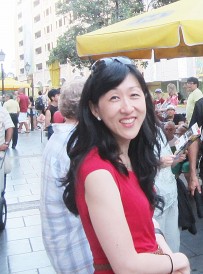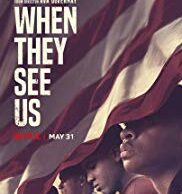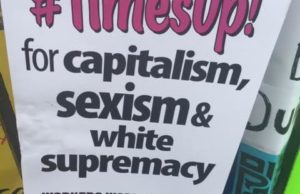White and Yellow: Overcoming Racism
By Grace Ji-Sun Kim
Race Relations
“It’s so nice and warm on the inside that you forget that there’s an outside. The worst of it is, the crab that mostly keeps you down is you…The realization had her mind on fire.”
—Terry Pratchett, Unseen Academicals
I was heading home from speaking at the Presbyterian Church in Canada, Synod of British Columbia meeting when a short incident on the plane ended a rather wonderful and fruitful trip on a sore note. It was a long flight home from Vancouver to Philadelphia. My eleven year old daughter, Elisabeth, and I had to get up at 5 am to catch the early morning flight back home. We left Vancouver around 7 am, transferring in Dallas to get to Philadelphia around 9 pm. It would be another hour’s drive before we got home.
On the flight from Dallas to Philadelphia, I was seated in the second to the last row with Elisabeth. There was an elderly white couple seated behind us in the last row of the plane. I have traveled enough times by plane to know the etiquette of deplaning. The first rows begin to move down the aisle, and everyone else waits their turn to follow them. It is important that this is a unique situation. There are no choices. There is only one way out for everyone, unlike lines at a supermarket or doors in a sanctuary.
One person violated this rule when the plane opened its doors in Philadelphia due to more than thoughtlessness or rudeness. Thoughtlessness is based on oversight. Rudeness is asserting oneself in a situation just to feel a momentary state of power over another. This case was more hurtful in that it invoked the notion that this person was fundamentally better than us.
As we got up from our seats and stood in place to enter the aisle, the white woman behind me stood next to me in the aisle and was determined to gain the place in the line ahead of me. Elisabeth was standing by her seat in the row beside me, and the woman’s husband was standing behind us in the aisle.
We stood a long time, as it seemed to take longer than usual for the passengers ahead of us to file out of the passengers’ cabin. When it became closer for our row to exit, the elderly woman beside me started walking ahead and somehow got three rows in front of us. I am not sure how she managed that, but she did, leaving her husband behind us. So far, we have simple rudeness.
As she left the plane, she was about eighteen passengers ahead of me on the ramp. So, when it was my turn to walk out, I asked her husband if he wanted to go ahead of us, and he politely said, “Please go ahead.” So, my daughter and I stepped from the passenger cabin.
As we passed the elderly woman on the terminal ramp, she had an angry look on her face as my daughter and I emerged from the door ahead of her husband. She was waiting for her husband in disgust. Her displeasure was written on her face, and as we walked past her, she said aloud to her husband, “I can’t believe you allowed the Chinese to get ahead of you!”
She said it loud enough so that I could hear. As the words left her mouth, her spitefully-based statement to her husband angered me more than such events may warrant. My first thought was the perception that an Asian is always already viewed as a foreigner no matter how long they have been living in this country. Even fourth or fifth generation Asians are viewed as the “perpetual foreigner.” Asian Americans have been depicted as “perpetual foreigners,” “unassimilatable,” and other stereotypes that reveal historic and persistent racism experienced by this racial/ethnic group. For example, almost every Asian in America has been afflicted with the perpetual foreigner syndrome. Many have been asked, “Where are you really from?” This loaded question, which I shall call the “really-question,” differs from the usual one, “Where are you from?” The really question figuratively and literally ejects the Asian American respondent to Asia, because the assumption behind the question, even if the questioner is oblivious to it, is that Asian Americans cannot be “real” Americans.
Asian American others, even if they are descendants of railroad workers, are assumed to be foreigners, while the white questioners, even if they are descendants of first generation immigrants, center themselves as “true” Americans. Generally, there is no intention of offense, much less malice, on the part of a white questioner whose American identity would never be called into question. Nonetheless, the person who is asking the really-question brings to mind all the epithets that our racialized society heaps upon Asian Americans: foreigner, unassimilatable, not American, someone who simply does not belong in American society, or, to use the “O” word, an “Oriental.”[i]
My second thought was that it wasn’t so much that she didn’t allow for the possibility that I was Korean (or Vietnamese or Thai or Mongol or Tibetan or Japanese) and not Chinese. It was her tone and false understanding of Asians in general. In her mind, white people cannot allow Asians to get ahead of them in any aspect of their lives. At many times and in many places, I have felt that communities around me generate the perception that they cannot allow an Asian to get ahead of them. There appears to be a glass ceiling that prevents Asians to get ahead as we are viewed as good, but not good enough to be at the top. But isn’t that in some way a problem with how I feel more than in what I experience?
Somehow, those of us who look different by nature are regarded as secondary human beings, and all is good if our social position mimics our role marked by natural genetic variation. Once some see us as getting out of that secondary status or achieving more than our subordinate status dictates, we are ignored, blamed, and made the “other.” One’s “Asianness” signifies to the white dominant group that s/he is a foreigner. This is true even if one is a second, third, or fourth generation “immigrant.” It is this racial difference, this physical difference of appearance, which marks Asian Americans as “other,” creating the status of “perpetual foreigner,” which functions to permanently marginalize Americans of Asian descent. For women, it is even more complex: they have to endure both the patriarchal attitudes of their Asian ethnicity and those of their U.S. context.[ii]
Whiteness
My airplane incident is rooted in white privilege and how society views race. Critical Race Theory emerged and evolved out of opposition to dominant conceptions of race, racism, and equality. What surfaced was a commitment to racial justice.[iii] “Whiteness” is the ideology of calling people in the United States of different ethnicities (Irish, English, French, German, Italian, and so forth) who have somewhat fair skin, white. The purpose is not to find a common ethnic name for these people, but rather, white is actually a term of “ethnic erasure.” As a consequence, the distinct histories and ethnicities of people in this group are erased by being made “white.” Furthermore, this term “white” creates privileged groups in relation to all “non-white” people. The problem is the grouping of a privileged group on the basis of a socially-constructed whiteness.[iv] Therefore, whiteness needs to become visible as a racial construction. Whiteness shapes and constitutes mainstream U.S. culture and society, and seeks to develop ethical responses.[v] My experience on that plane was precisely rooted in white privilege, which allows the white woman to believe that she has every right to discriminate and believe that she can get away with it.[vi]
Thus, whiteness erases an entire group of different people with different ethnicities into one singular monolithic group as if their differences do not exist. This erasure makes the “white group” appear pure while other groups are considered impure. People who are different from the white group are considered ethnic, while the white group is not. Ethnic people belong to the “different,” less dominant group. Such categories should be viewed and used with suspicion, as it is usually those with power who get to do the labeling and naming. This happened quite overtly in my airplane experience, as the white woman not recognizing the diversity of Asia just decided to call me “Chinese.”
To work towards a just society, it is necessary to dismantle dominant social structures and replace them with a paradigm of plurality, equality, and mutuality. This paradigm shift recognizes that there is a plurality of centers and embraces that rather than searching for purity, we need to embrace “hybridity.” “White privilege” is the outcome of a pervasive presumption of the racial superiority of whiteness.[vii] White superiority is the presumption, and white privilege is the material consequence. We need to renegotiate justice by making the privilege visible and dismantling it. Race is not a social category that stands alone, but rather a dynamic interaction with gender, sexuality, and class. Race must be acknowledged as having been assigned such tremendous significance, both historically and today, in that it provides unearned advantages to those racialized white, albeit to varying degrees.[viii] White privilege is so embedded in our culture and society, it is important to recognize this so that we can fight against it. The white woman on the plane sincerely believed that Asians are people who cannot “get ahead” of white people, and therefore, even during a simple act of deplaning, she can barge ahead of me, as it is her right to do so under “white privilege.”
Final Thoughts
This plane incident has been quite painful to me, especially since I did not experience it alone. My young daughter also had to experience first-hand the humiliation of being attacked on the basis of our skin color. I am not sure why the disposition to demean some other people based on racial background still exists and permeates much of our society. The ignorance or lack of respect for people with differences becomes visible in so many aspects of our lives. However, we need to move beyond the color of our skin or the size of our eyes or noses. We need to celebrate overcoming the evil influence created by a viral perception of differences that are before us rather than being fixated on them and allowing them to come between people. It may be at that moment when it occurred to me that racism is so deeply embedded in our culture and steps need to be taken to dismantle it.
I envision a world for my daughter in which people of all races, ethnicities, sexual orientations, and social classes can come together in harmony and love. My daughter’s world should be free of hatred, racism, sexism and other “isms.” Each one of us can work toward it and try to help it happen.
[i] See Joseph Cheah, Race and Religion in American Buddhism (Oxford: Oxford University Press, 2011), 132.
[ii] See Gale A. Yee, “Where Are You Really From? An Asian American Feminist Biblical Scholar Reflects on Her Guild” in New Feminist Christianity: Many Voices, Many Views edited by Mary E. Hunt & Diann L. Neu (Woodstock: Skylight Paths, 2010), 79.
[iii] See Jacqueline Battalora, “Whiteness: The Workings of an Ideology in American Society and Culture” p. 3-23, in Gender, Ethnicity, and Religion: Views from the Other Side, edited by Rosemary Radford Ruether (Minneapolis: Fortress Press, 2002), 3.
[iv] See Rosemary Radford Ruether, editor, Gender, Ethnicity, and Religion: Views from the Other Side (Minneapolis: Fortress Press, 2002), x, xi.
[v] See Battalora, “Whiteness: The Workings of an Ideology in American Society and Culture,” 3.
[vi] See Joseph Cheah, “Race and Religion in American Buddhism” (Oxford University Press, 2011).
[vii] See Tim Wise: Anti-Racist Essayist, Author, and Educator (www.timwise.org).
[viii] Ibid., 10-13.
_________________________________________________________
 Grace Ji-Sun Kim obtained her M.Div. from Knox College and her Ph.D. from the University of Toronto. She is an Associate Professor of Doctrinal Theology and the Director of the MATS program at Moravian Theological Seminary. She is the author of The Grace of Sophia (Pilgrim), The Holy Spirit, Chi and the Other (Palgrave Macmillan) and Colonialism, Han and the Transformative Spirit (Palgrave Macmillan) in addition to several journal articles, book reviews, and chapters. Presently, she is working on a biblical commentary on First and Second Chronicles, Ezra, and Nehemiah. Dr. Kim is especially active in the American Academy of Religion (AAR), serving on the Research Grants Jury Committee, the Women of Color Scholarship, Teaching, and Activism Consultation steering committee as a Co-Chair, and the Comparative Theology Group and Religion and Migration Group steering committee. She also serves on the Editorial Board for the Journal for Religion and Popular Culture, and is a referee for the Journal of Race, Ethnicity, and Religion, the Journal of Religion and Popular Culture, and The Global Studies Journal.
Grace Ji-Sun Kim obtained her M.Div. from Knox College and her Ph.D. from the University of Toronto. She is an Associate Professor of Doctrinal Theology and the Director of the MATS program at Moravian Theological Seminary. She is the author of The Grace of Sophia (Pilgrim), The Holy Spirit, Chi and the Other (Palgrave Macmillan) and Colonialism, Han and the Transformative Spirit (Palgrave Macmillan) in addition to several journal articles, book reviews, and chapters. Presently, she is working on a biblical commentary on First and Second Chronicles, Ezra, and Nehemiah. Dr. Kim is especially active in the American Academy of Religion (AAR), serving on the Research Grants Jury Committee, the Women of Color Scholarship, Teaching, and Activism Consultation steering committee as a Co-Chair, and the Comparative Theology Group and Religion and Migration Group steering committee. She also serves on the Editorial Board for the Journal for Religion and Popular Culture, and is a referee for the Journal of Race, Ethnicity, and Religion, the Journal of Religion and Popular Culture, and The Global Studies Journal.




Pingback: White and Yellow: Overcoming Racism (Participation) | CES 101
Pingback: White and Yellow: Overcoming Racism (Participation) | CES 101
Pingback: White and Yellow: Overcoming Racism (Participation) | CES 101
Pingback: White and Yellow: Overcoming Racism (Participation) | CES 101
Pingback: White and Yellow: Overcoming Racism | The Racist and Unoriginal Anglo-American Entertainment Industry
Pingback: White and Yellow: Overcoming Racism | The Racist and Unoriginal Anglo-American Entertainment Industry
Pingback: White and Yellow: Overcoming Racism | The Racist and Unoriginal Anglo-American Entertainment Industry
Pingback: White and Yellow: Overcoming Racism | The Racist and Unoriginal Anglo-American Entertainment Industry